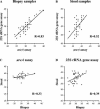Novel real-time PCR assay for detection of Helicobacter pylori infection and simultaneous clarithromycin susceptibility testing of stool and biopsy specimens
- PMID: 15472302
- PMCID: PMC522301
- DOI: 10.1128/JCM.42.10.4512-4518.2004
Novel real-time PCR assay for detection of Helicobacter pylori infection and simultaneous clarithromycin susceptibility testing of stool and biopsy specimens
Abstract
A biprobe real-time PCR protocol, followed by hybridization melting point analysis, to detect point mutations in the 23S rRNA gene of Helicobacter pylori associated with clarithromycin resistance was established and evaluated in a clinical study. Of 92 patients who underwent endoscopy, 45 were found to be H. pylori infected and invariably were also culture positive. Of the 45 isolates, 11 were shown to be resistant to clarithromycin by E-test. With respect to the detection of H. pylori infection, PCR showed sensitivities of 100% in biopsies and 98% in stool specimens and a specificity of 98% in both biopsy and stool samples. All clarithromycin-sensitive cases were identified as such by PCR in both biopsy and stool samples. Of the cases with a resistant strain, eight were identified as such in stool DNA and nine were identified in biopsy DNA. Failure of PCR to detect the resistant genotype in the biopsy DNA, stool DNA, or both (one case) was associated with mixed populations. In these cases, patients had not been treated for H. pylori infection before, and the sensitive population showed to be present in considerably higher numbers than the resistant population. In five of six cases in which infection with a resistant genotype only was identified by PCR, the patients had received clarithromycin-based eradication therapy in the past. Thus, the assay presented provides a highly accurate noninvasive method to detect H. pylori infection in stool and at the same time allows for culture-independent clarithromycin susceptibility testing.
Figures


Similar articles
-
Dual-priming oligonucleotide-based multiplex PCR for the detection of Helicobacter pylori and determination of clarithromycin resistance with gastric biopsy specimens.Helicobacter. 2009 Feb;14(1):22-8. doi: 10.1111/j.1523-5378.2009.00654.x. Helicobacter. 2009. PMID: 19191892
-
Application of real-time PCR stool assay for Helicobacter pylori detection and clarithromycin susceptibility testing in Brazilian children.Helicobacter. 2011 Aug;16(4):311-5. doi: 10.1111/j.1523-5378.2011.00845.x. Helicobacter. 2011. PMID: 21762271
-
Evaluation of the novel Helicobacter pylori ClariRes real-time PCR assay for detection and clarithromycin susceptibility testing of H. pylori in stool specimens from symptomatic children.J Clin Microbiol. 2007 Jun;45(6):1718-22. doi: 10.1128/JCM.00103-07. Epub 2007 Mar 28. J Clin Microbiol. 2007. PMID: 17392440 Free PMC article.
-
Detection of clarithromycin-resistant Helicobacter pylori by stool PCR in children: a comprehensive review of literature.Helicobacter. 2013 Apr;18(2):89-101. doi: 10.1111/hel.12016. Epub 2012 Oct 12. Helicobacter. 2013. PMID: 23067446 Review.
-
[Detection of Helicobacter pylori 23S rRNA gene mutation associated with clarithromycin resistance and its clinical applicability].Nihon Rinsho. 1999 Jan;57(1):87-92. Nihon Rinsho. 1999. PMID: 10036941 Review. Japanese.
Cited by
-
Normalized real-time PCR for diagnosis of H. pylori infection.Qatar Med J. 2014 Dec 9;2014(2):123-9. doi: 10.5339/qmj.2014.19. eCollection 2014. Qatar Med J. 2014. PMID: 25745602 Free PMC article.
-
Development of novel real-time PCR assays for detection and differentiation of eleven medically important Aspergillus and Candida species in clinical specimens.J Clin Microbiol. 2007 Mar;45(3):906-14. doi: 10.1128/JCM.01344-06. Epub 2007 Jan 24. J Clin Microbiol. 2007. PMID: 17251398 Free PMC article.
-
The State of the Art of Molecular Fecal Investigations for Helicobacter pylori (H. pylori) Antibiotic Resistances.Int J Mol Sci. 2023 Feb 22;24(5):4361. doi: 10.3390/ijms24054361. Int J Mol Sci. 2023. PMID: 36901792 Free PMC article. Review.
-
Application of PCR and Microscopy to Detect Helicobacter pylori in Gastric Biopsy Specimen among Acid Peptic Disorders at Tertiary Care Centre in Eastern Nepal.Can J Infect Dis Med Microbiol. 2019 Feb 5;2019:3695307. doi: 10.1155/2019/3695307. eCollection 2019. Can J Infect Dis Med Microbiol. 2019. PMID: 30867850 Free PMC article.
-
Optimal therapy for Helicobacter pylori infections.Nat Rev Gastroenterol Hepatol. 2011 Feb;8(2):79-88. doi: 10.1038/nrgastro.2010.210. Nat Rev Gastroenterol Hepatol. 2011. PMID: 21293508 Review.
References
Publication types
MeSH terms
Substances
LinkOut - more resources
Full Text Sources
Other Literature Sources
Medical
Miscellaneous

